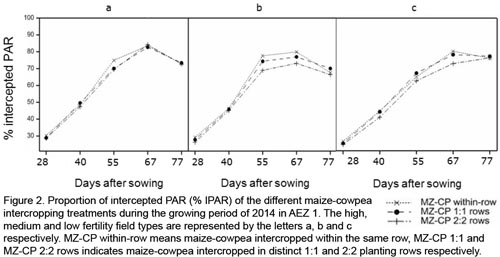Two on-farm trials were conducted in the 2013 and 2014 cropping seasons in the northern Guinea savannah agroecological zone (AEZ 1) and the Sudan savannah agroecological zone (AEZ 2) of Ghana to evaluate the effect of intercropping patterns and the effect of cowpea-maize relay intercropping on crop productivity. The intercropping patters were within-row intercropping and 1:1 and 2:2 distinct rows of maize- legume (Figure 1a, b). The legumes tested included cowpea, soyabean and groundnut. The trials were conducted across fields of different soil fertility levels. In this article, radiation interception and land equivalent ratios of the different intercropping systems are discussed.
|
Figure 1. Visual appraisal of a) within-row maize-legume and b) distinct 1:1 planting rows of maize-legume intercropping systems as well as c) and d), how radiation interception was measured. In the picture Michael Kermah is taking some radiation measurements. |
|
|
In the 2014 intercropping trials, radiation interception (Photosynthetically Active Radiation, PAR) of the different intercropping systems tested was measured with the AccuPAR LP-80 ceptometer1 (Figure 1c,d). In most cases, the IPAR was higher for the within-row maize-cowpea system than the other two intercrop systems, particularly at 55 to 67 DAS which corresponds to early to mid-pod filling stage of the cowpea (Figure 2). The differences were significant with P<0.001 for 28 and 55 DAS (days after sowing) and P=0.009 and 0.010 respectively for 40 and 67 DAS. Only at 77 DAS the differences in intercepted PAR were not significant. |
|
The land equivalent ratios (LER) results indicate that all the intercropping systems tested were efficient in using the available environmental resources and more productive than the sole crops of legumes and maize. These were observed in all three soil fertility levels and in both AEZs. However, in most cases, the within-row intercropping system gave higher LER and intercrop productivity. The 1:1 maize-legume distinct planting rows also seems to give better LER and productivity than the 2:2 system. The LERs were higher in the low than the high fertility fields in both AEZs.
Michael Kermah, Wageningen University, The Netherlands
1 Decagon Devices Inc. Pullman, Washington



